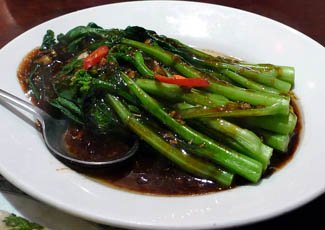Selection
Gai lan is a popular cabbage vegetable native to mainland China. It is one of the most popular leafy vegetables found at local markets across East Asia and Southeast Asia.
Today, along with similar seasonal greens such as choy sum (Chinese flowering broccoli), komatsuna, tatsoi, etc., it is also found at specialty grocers and Asian markets in Europe, Australia, and the United States.
Chinese broccoli is usually grown as a fall, winter, or early spring crop. Fresh greens begin arriving at markets, peaking from fall through spring. It can be grown year-round in greenhouse practice.
Harvest gai lan before the flowers open, although a few open flowers won’t decrease the quality of the vegetable.
Harvest stalks in the early morning to minimize water stress, and tie them into bunches of 5 to 7 plants. The main stem should be 1.5-2.0 cm wide at the base and 4-6 inches long.
Look for fresh greens featuring crispy, pale green stems and deep blue-green leaves. A few open flowers won’t decrease the quality of the vegetable. Avoid stems with wilt, spotted or discolored leaves, and bolted florets.
Storage
Chinese broccoli experiences a quick loss of moisture, given the large surface area of its leaves, if kept exposed to higher temperatures. At home, store the leaves in the refrigerator soon after buying. Place them inside a breathable polythene bag in a crisper drawer. Maintain a relative humidity of 95-100%.
Although they can be stored for up to 3 days in cold storage, fresh Chinese broccoli greens should be used as soon as possible to obtain maximum nutritional benefits.
Preparation and Serving Methods
Chinese broccoli features very prominently in Cantonese, Thai, Malay, Korean, and Vietnamese cooking. Fresh leaves, flower buds, and stems are used in a variety of cuisines all over East Asia and in the U.S.
Before cooking, wash the leaves thoroughly in clean running water to remove sand or any insecticide residues.
Peel stalks that are more than 1/2-inch in diameter, then halve lengthwise. Chop the stalks and leaves into 2.5-inch long pieces, keeping the stalk ends separate from the leaves.
Tender leaves and flower tips of Gai Lan can be consumed raw. But larger leaves and stems impart a slightly bitter taste and are usually enjoyed stir-fried, boiled, blanched, braised, or steamed. Its pungent, mustardy flavor is somewhat toned down if cooked with aromatics or light sauces to help balance out the flavor.
Gai Lan complements well with sauces such as garlic, oyster, or soy. It mixes well with spices like ginger, meats such as pork and beef, fish, mushrooms, pasta, rice, pine nuts, bell pepper, and basil.
Here are some serving tips:
 |
| Gai lan (stir-fry Chinese broccoli/kale). Courtesy: Ewan Munro |
-
Fresh tender gai lan is enjoyed raw in salads, mixed with other seasonal greens and vegetables.
-
Chinese broccoli may be preserved as a pickled vegetable (Gat kimchi 갓김치), which is a popular recipe in Korea and China. It can be substituted for choy sum, broccolini, bok choy, etc., for a more highly flavored version of kimchi.
-
It complements well when added to soups and stews or braised with aromatic spices such as garlic, star anise, garlic, and scallions.
-
The leaves and stems can be stir-fried with other vegetables, mixed into noodle soups, or lightly sautéed and served with savory main dishes.
-
They can also be used as a wrap for cooked meats, herbs, and sauces, mixed into pot pies, or blended into green juices and smoothies.
Safety profile
-
Reheating Gai lan leftovers may cause the conversion of nitrates to nitrites and nitrosamines by certain bacteria that thrive on prepared nitrate-rich foods, such as Gai lan, mustard, spinach, and many other green vegetables. These poisonous compounds may prove harmful to health.
-
Phytates and dietary fiber present in Chinese kale may interfere with the bioavailability of iron, calcium, and magnesium.
-
Chinese broccoli, being a Brassica family vegetable, contains oxalic acid, a naturally occurring substance found in some vegetables that may crystallize as oxalate stones in the urinary tract in some people. People with known oxalate urinary tract stones are advised to avoid eating vegetables belonging to the Crucifer family. Adequate intake of water is, therefore, necessary to maintain normal urine output.
-
Chinese broccoli may also contain goitrogens which may interfere with thyroid hormone production and can cause thyroxin hormone deficiency in individuals with thyroid dysfunction.
(Medical Disclaimer: The information and reference guides on this website are intended solely for the general information of the reader. It is not to be used to diagnose health problems or for treatment purposes. It is not a substitute for medical care provided by a licensed and qualified health professional. Please consult your health care provider for any advice on medications.)
You may also like to read ≻≻
≺≺ Back to Vegetables from Chinese broccoli. Visit here for an impressive list of vegetables with complete illustrations of their nutrition facts and health benefits.
≺≺ Back to Home page.
Further reading:
-
Stanford School of Medicine Cancer information Page- Nutrition to Reduce Cancer Risk (Link opens in new window).
-
Kitazawa Seed Company (Link opens in new window).
-
Specialty Produce- Gai lan (Link opens in new window).

